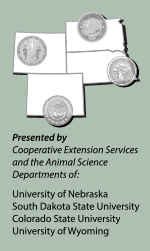High-altitude Disease, PAP, Feedlot Hypertension, Respiratory Issues: Are they linked?
LOVELAND, Colo. (Nov. 18, 2015) — “It is no longer true that brisket disease is only occurring at a high altitude,” Texas Tech’s Joe Neary emphasized Nov. 18, during his remarks to the more than 700 attendees at the Range Beef Cow Symposium in Loveland, Colo.

Joe Neary
Historically, high-altitude disease — also called brisket disease, high-mountain disease, or mountain sickness — has been associated primarily with cattle at elevations of 8,000-10,000 feet. But, Neary, who completed his doctoral degree at Colorado State University and now is assistant professor of animal health and well-being at Texas Tech University’s Department of Animal and Food Sciences, shared that congestive heart failure is becoming increasingly problematic at elevations as low as 2,000-4,000 feet — particularly among feedlot cattle.
At high elevations, brisket disease has been determined to be caused when cattle have to function with low oxygen levels, which restricts blood flow through the pulmonary arteries of the lung. The limited oxygen causes the pulmonary arteries to contract and develop thickened walls. This leads to high blood pressure in the pulmonary artery, increasing the workload — and size — of the right side of the heart. When the pulmonary arteries remain contracted, the heart will eventually fail.
Now this same phenomenon with an enlarged right ventricle of the heart and heart failure is being identified among cattle at lower elevations. Neary cited a study that found a doubling of the incidence of heart failure among cattle in feedlots from 2000 to 2008.
Neary said it can be extremely hard to differentiate between the early stages of brisket disease and respiratory disease, and he suspects in many past cases brisket disease has been overlooked and mistakenly identified as pneumonia.
“Calves presenting signs of pneumonia may actually have brisket disease, pneumonia or both. I’ve been surprised many times by necropsy findings,” he shared. If the right ventricle of the animal’s heart was enlarged, it was brisket disease.
To mitigate the effects of brisket disease within a cow herd, Neary shared that previous research shows measuring pulmonary artery pressure, or PAP testing, has helped identify cattle at risk for brisket disease. Along with that, brisket disease is moderately heritable, so screening breeding stock and selection pressures implemented by ranchers at high elevations has been successful in reducing death loss in cow herds on high-altitude ranches.
For the future, to gain a better understanding of the extent to which brisket disease is affecting the beef industry, particularly in feedlot cattle, Neary encourages producers and feeders to pay closer attention to sick and dead animals and have a necropsy conducted if they suspect a problem. Neary also said this is a disease that warrants further study in low-elevation feedlots.
Lastly, Neary said, “Brisket disease is not unique to high altitude, so please don’t’ use the term high-altitude disease or high-mountain disease anymore.”
Editor’s Note: This summary was written under contract or by staff of the Angus Journal®, which retains the copyright. To request to reprint this article, contact Shauna Rose Hermel, editor, at 816-383-5270. PowerPoints are posted with permission of the presenter and may not be reproduced in whole or in part without the express permission of the presenter. Angus Journal claims copyright to this web site as presented. We welcome educational venues and cattlemen to link to this site as a service to their audience.
The Angus Journal's coverage of the event is made possible through collaboration with the event committee and sponsorship of LiveAuctions.tv. For questions about this site, or to notify us of broken links, click here. Look for additional coverage in the Angus Journal, the Angus Beef Bulletin, the Angus Journal Daily, the Angus Beef Bulletin EXTRA and Angus TV.


